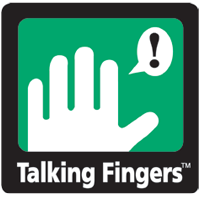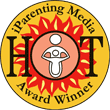
Wordy Qwerty
Foundations for Reading and Writing Fluency
Reading and Spelling Software for 2nd and 3rd Grade
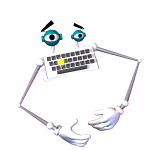 The sequel to the Read, Write & Type, Wordy Qwerty – Foundations for Reading and Writing Fluency, takes 7-9 year olds through the next steps of reading and writing fluency, and picks up where our award-winning software, the Read, Write & Type leaves off.
The sequel to the Read, Write & Type, Wordy Qwerty – Foundations for Reading and Writing Fluency, takes 7-9 year olds through the next steps of reading and writing fluency, and picks up where our award-winning software, the Read, Write & Type leaves off.
 After successfully completing Read, Write & Type, most 6-7 year olds are able to write any word they can say. But they may not spell them all correctly, because they need to know a bit more about spelling conventions and about how words are constructed in English. This is where Wordy Qwerty comes in. In 20 consecutive lessons, woven together with fun-to-play games and delightful songs that will stay in their heads (and an audio CD they can play in the car or on their audio CD player).
After successfully completing Read, Write & Type, most 6-7 year olds are able to write any word they can say. But they may not spell them all correctly, because they need to know a bit more about spelling conventions and about how words are constructed in English. This is where Wordy Qwerty comes in. In 20 consecutive lessons, woven together with fun-to-play games and delightful songs that will stay in their heads (and an audio CD they can play in the car or on their audio CD player).
How it Works
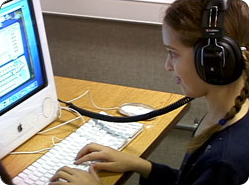 The overall purpose of Wordy Qwerty: Foundations for Reading and Writing Fluency, is to improve phonological and morphological sensitivity, to develop a deeper understanding of how words are constructed in English, and to provide reading and writing activities with helpful feedback, in order to increase fluency and comprehension in reading and writing. Wordy Qwerty has 20 lessons, with six activities per lesson, that present the following foundations for fluency:
The overall purpose of Wordy Qwerty: Foundations for Reading and Writing Fluency, is to improve phonological and morphological sensitivity, to develop a deeper understanding of how words are constructed in English, and to provide reading and writing activities with helpful feedback, in order to increase fluency and comprehension in reading and writing. Wordy Qwerty has 20 lessons, with six activities per lesson, that present the following foundations for fluency:
- Some sounds can be represented in several different ways.
- Most words follow about 20 easy spelling rules.
- There are many word families, (words that sound the same, or rhyme). By changing the first letter(s), you can make hundreds of words.
- Some words are “outlaws”. They don’t follow the rules. They must be recognized quickly and automatically.
- Writing to dictation develops vocabulary, comprehension and fluency as well as spelling skills.
- Reading (and filling in missing words) develops vocabulary, comprehension, and fluency skills.
20 LESSONS IN WORDY QWERTY (SPELLING RULES)
- Silent E
- Sounds of C
- Sounds of G
- J or DGE
- W or WH
- C or K
- CK or K
- CKS or X
- CH or TCH
- LL, SS, FF, ZZ
- OI or OY
- VE Words
- Open Syllables
- Double Consonants
- Doubling rule
- ER, IR, OR, UR, EAR
- I Before E
- Plurals: Add ES
- Plurals: Y to IES
- Plurals: F to VES
Product Tour
The Six Steps to Reading and Writing Fluency with Wordy Qwerty
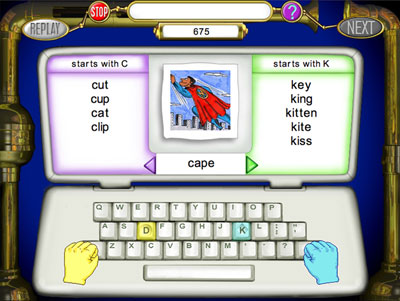
Patterns: Children generate two lists of words by typing the names of pictures and sorting the words by a given characteristic. They are directed to notice the patterns,” or spelling rules, by comparing the two lists. If they can’t sound out the words or spell them correctly, the Helping Hands will assist them. Qwerty and Midi talk about the differences between the two lists and derive the 20 spelling rules which then are woven into the lyrics of delightful songs.
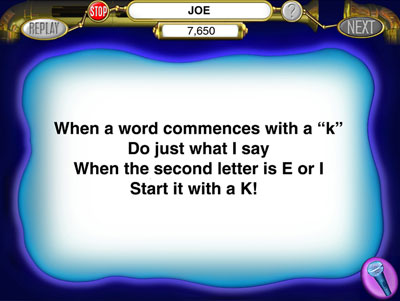
Karaoke: Rhymes and songs are memorable and fun. There is a catchy song about each of the 20 spelling rules. Children read the lyrics on the screen and can sing along if they want. Often the lyrics contain examples of the words that reflect the spelling rule. Children are motivated to read the words while the song is playing, or while they are singing it themselves.
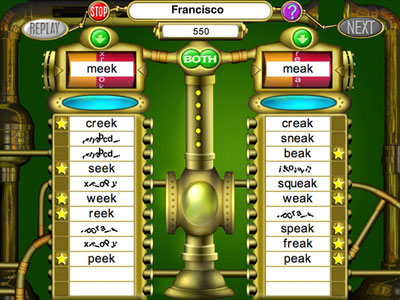
Recycler: Lots of words that rhyme can be made just by changing the first letter or letters of the word. Some words sound the same, or rhyme, but use a different combination of letters to represent the same sound. In this game, chidren learn different vowel combinations that can make the long vowel sound. They watch the RECYCLER drum whirl as it changes the first letter(s) of two rhyming words. They learn to quickly distinguish real words from non-words. The non-words are vacuumed away. Players that score less than 90% on the first try are asked to study the list of real words. If any are not familiar, they can click on the word and hear it used in a sentence. Then they are asked to play the game again.
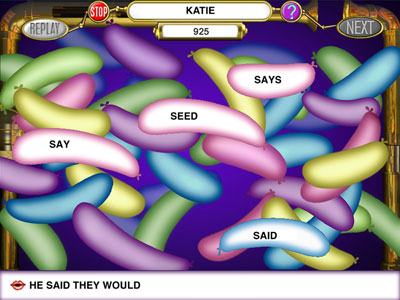
Pop-a-Wordzz; “Outlaw” words are best memorized by learning to recognize them quickly. In this arcade-type game, children find words in a 4 word phrase as each word appears briefly, along with non-target words, in a cluster of colorful balloons. As children click on the correct balloons, they “pop”. The faster they recognize the correct words, the more points they make.
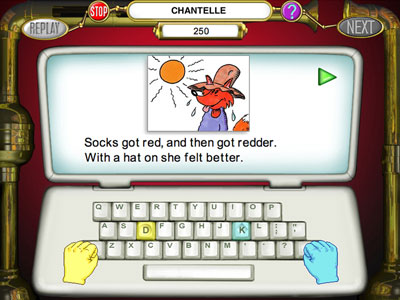
Write Stories: In these cleverly illustrated 8-line rhymes, children hear and see the first line, and have to type out the second line after it is dictated. They can see and hear the dictated line as often as they need, but get more points if they remember the sentence and try to spell the words correctly. These little stories are full of words that require using the spelling rule just presented.
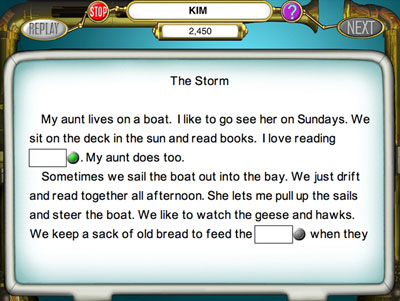
Read Stories: Here are some short, engaging stories that develop comprehension, vocabulary, and fluency. Every so often, there is a word missing, and children have to choose among three possible words, the word that best fits the meaning of the sentence. These stories also include words that utilize the spelling rule, or the “outlaw” words learned in that lesson.
FAQs
Frequently Asked Questions about Wordy Qwerty – from Talking Fingers, Inc.
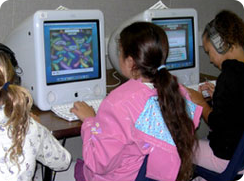
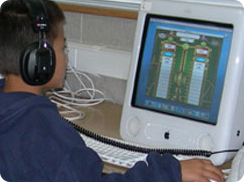
Q. What uniquely sets Wordy Qwerty apart from the hundreds of software reading products?
A. Wordy Qwerty — Foundations for Reading and Writing Fluency, demystifies spelling and makes it fun to learn to write and read words. It capitalizes on the importance of spelling as an essential component of reading and writing fluency.
Wordy Qwerty is targeted at 7 to 10 year olds who have learned the basics of phonics and word identification and are poised to master more complex reading and writing skills in order to become enthusiastic and capable readers and writers. It uniquely uses a writing-to-read approach in order to provide individualized feedback and to activate and connect essential areas of the brain.
Two engaging characters, Midi the musician and Qwerty the word coach, enlist children to help them accumulate the “spheres” that are needed to play Midi’s music machine. Children do this by successfully mastering six activities in each of twenty lessons. They learn to recognize patterns in words, type to dictation, write and read stories, and listen to and sing songs that will help them remember how words are spelled and pronounced and what they mean.
Q. Where can I go to get a quick demo of Wordy Qwerty?
A. Click here
Q. Can any 7 to 10 year old child pick up and use Wordy Qwerty?
A. Yes, any 7 to10 year old can use the program. They’ll do even better if they’ve learned keyboarding, phonemic awareness and basic spelling conventions first, with our flagship Read Write & Type program.
Q. Many reading products claim to be research-based; Why is that important?
A. It’s important for developers of reading products to base their products on the latest and most reliable reading research. It is also important to find out whether the product they have created really works to help children learn to read. This can only be determined via well-designed classroom research, with a variety of children using the product. The most current research in reading has found that, to become successful, fluent readers, children need phonics-based instruction that is systematic and explicit, with ample opportunity for individualized instruction and feedback. For fluency and comprehension, they need to develop strategies that use a knowledge of how words are constructed in English. Talking Fingers has incorporated these principles into its approach of using writing as a route to reading.
Q. Is Wordy Qwerty research-based?
A. Yes. Research with Wordy Qwerty was conducted by reading specialists at Southern Methodist University, in Dallas, Texas, as part of the development of the program.
Wordy Qwerty‘s creator, Dr. Jeannine Herron, Ph.D., has 30 years experience in brain and reading research. Her approach has been tested and proven successful through research using Read Write & Type, in public schools across California, as well as through research by noted reading specialist, Joseph Torgesen, at Florida State University. Research with both Read Write & Type and Wordy Qwerty have been funded by private foundations as well as the National Institute of Child Health and Human Development (NICHD).
Q. What will children get out of Wordy Qwerty?
A. Researchers report that fluent readers and writers access the words they read and write from a “database” located in the left hemispheres of their brains. This database stores both the sounds and meanings of the words we read and write. Wordy Qwerty helps children build and automatically access this invaluable left-brain data. They see, hear and type scores of words, individually, in sentences, and in stories. They store the motor memory of typing, and the sound, sight and meaning of each word in their brains, for future reference.
Wordy Qwerty uses games, songs, rhymes, storytelling and rewards to teach children 20 spelling rules, introduce them to word families, and identify the “outlaw words” (words that do not conform to spelling conventions and must simply be memorized by sight). As they master these concepts, the world of reading and writing widens beyond belief. Children fearlessly and confidently tackle new words because they have learned the rules and strategies that will help them succeed. The skills Wordy Qwerty fosters will remain embedded throughout their lifetime.
Q. What is the Talking Fingers, Inc. approach to reading and writing?
A. The Talking Fingers approach to reading and writing is based on a simple idea: Text is speech made visible. We use our mouths to talk, to make the sounds of words. We use our fingers (with a pencil or keyboard) to represent those sounds on paper.
There are roughly 40 sounds (or phonemes) in English. It takes only 26 letters to stand for those sounds, to make any spoken word visible. When children learn to link those sounds with letters, they can use the alphabet code to write any word they can say. Their fingers are “talking”.
Writing (encoding words), is a natural, speech-based route to reading. Each word has to be mentally pronounced and then spelled out one sound at a time. Children store this new database of word information near brain areas where speech and language comprehension are already stored. As children write, their mouths may be quiet, but their brains and their fingers are “talking.”
Q. Can you tell me a little about the product's creator?
A. Dr. Jeannine Herron has been involved in children’s education since 1955. This mother of two, and grandmother of five, has been teacher, activist, research scientist, adventurer, editor, writer, and educational software developer, and shows no signs of slowing down.
She began her career as an American teacher in the mid-fifties, teaching English, Mathematics, and General Science to middle and high school students in Ramallah, Jordan. Seven years later, she and her husband, and their two small children moved to Mississippi to be active in the civil rights movement. It was there that Jeannine became Co-founder and Program Director of the first Head Start project in the United States, the Child Development Group of Mississippi, an organization that served over 5,000 children.
Jeannine received her Ph.D. from Tulane University Medical School, and went on to Stanford Research Institute as a neurobiologist and neuropsychologist. In 1974, she moved to UCSF and was awarded a research fellowship from the National Institute of Health (NIH) to investigate the cerebral organization in left-handers, Her first book, Neuropsychology of Left-Handedness, was published by Academic Press in 1980. From 1976 to 1984 she continued at UCSF as research psychologist, contributing to all aspects of a large NIH-funded project studying dyslexia.
In 1982, she founded a non-profit organization for educational research that has produced more than 50 conferences across the U.S. to inform professionals in health, psychology and education about relationships between the brain and learning. She developed and carried out research with two major software programs funded largely by the National Institute for Child Health and Human Development (NICHD). She is still actively involved in lecturing and providing professional development for teachers.
Her experiences with children in Mississippi, her history in the classroom, her research in dyslexia, and her discoveries from teaching her own children to write, fueled her desire to develop practical tools to help children learn to read and write.
News & Reviews
Read the buzz on Wordy Qwerty — Foundations for
Reading and Writing Fluency
“Wordy Qwerty is my son’s favorite curriculum of the entire school year!”
“Awesome way to reinforce spelling rules!”
Read the 2011 reviews of Wordy Qwerty, on Homeschool Blogger.
